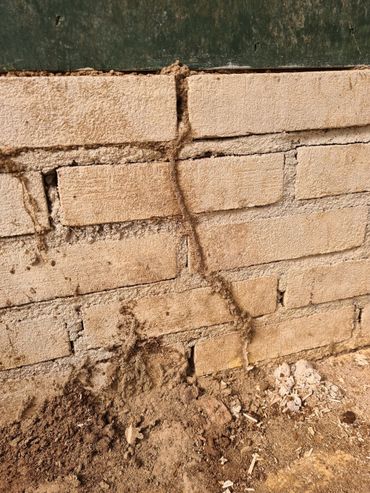
Nature Today | A termite’s first settlement in the Netherlands
Colony in South Holland
At the end of 2019, the pest manager sent a sample containing termites belonging to the species Reticulitermes to the Knowledge and Advisory Center for Animal Pests (KAD), which then shared it with the EIS Knowledge Center for Pests. The animals came from a tree in a building in the countryside of southern Holland. This is the first report of termite colony establishment in the Netherlands. Control measures have been taken on site, particularly in occupied areas of the building. However, the animals persisted, and a neighbor’s report in 2022, experiencing nuisances, prompted further investigation. This identification has been confirmed as an American ground termite Reticulitermes flavipes. The size of the colony is mapped: it stretches over two houses, one of which includes a building complex with greenhouses. In total, the colony is spread over an area of about 1,500 square meters. All types of wood are affected at the site, from construction wood to house components and exterior logs. According to residents, despite control measures, the colony has been developing for at least ten years. There are also nuptial flights, in which winged animals fly through the air to start a new colony with a mate. It must be said that it is still unknown whether males and females from the same colony can reproduce successfully.
The termites were undoubtedly brought with the plants from the Americas. Whether the sale of plants from this location (which has now ceased) caused the spread to other locations is not yet known, but should be further investigated. Year-round termite activity in wood parts (firewood, waste wood, dead trees) in the surrounding outdoor area is a concern. Termites are much less common here than in buildings, and the movement of infested wood may cause them to move to new locations.
After the discovery of the termite colony described here, colonies were found at two more locations where research is currently being conducted, the results of which will be available later.
prevent
Reticulitermes flavipes It is native to North America and lives mainly along the east coast from Mexico to the central part of the United States. Cold winters do not disturb the breed. In the United States, termites cause a lot of damage to wooden structures; For homeowners, expensive termite insurance and annual woodwork inspections are unavoidable. After importation, the species became established in southern Canada, Uruguay, Chile, Germany, Austria, France, Italy, and the Azores. In This breed has been in France for a long time, perhaps more than two centuries old and widespread. A Extensive study in Paris shows that R. flavipes Can be installed and expanded well in urban areas. Here, too, it incurs high control costs and has created special termite insurance and clauses in purchase contracts and provisions for termite-resistant wood in construction. The first discovery from Germany dates back to the 1980s, in Italy it was discovered only in 2008 and in the Azores in the same year. It seems likely that the species will make significant progress, and it is certainly not inconceivable that it will become invasive in the Netherlands as well.
Life
Termites are social insects that can form large colonies. Many species live in trees. Workers that damage wood and other cellulose-containing materials make up the largest portion of a termite colony. Reticulitermes-Species live on the ground and build ‘soil tunnels’ that are protected against dehydration by establishing a connection between a ground nest and a tree.
The damage was confirmed when various places were visited R. flavipes Damage to both houses is well advanced. There is damage to at least the first floor and roof structures from the basement. Due to this, the safety of houses and buildings has become questionable. It remains to be seen if the colony can still be contained at this point, but spreading out onto the ground outside of buildings certainly makes things more difficult.
the future
This is the first branch R. flavipes Naturally raises many questions and knowledge development is essential. It deals with assessment of establishment opportunities, detection methods, authorization of pesticides etc. Termites are a growing problem in light of climate change and the increase in commodity trade. It was already known that animals were occasionally brought into the Netherlands, but the case described here brings to attention the facts that settlement and even harassment have become possible.
NVWA was therefore introduced recently signal advice Presented to the Director of Nature, Ministry of Agriculture, Nature and Food Quality. This general advice calls for attention to be given to the role of various parties in control, the desire for rapid eradication, setting up the infrastructure for early detection and notification to the appropriate authorities, anticipating possible authorizations of pesticides and spreading knowledge about the risks. Spread in the community.
More info
- Read more in the trade journal article from Entomology Reports which you can download This website.
Text: Jinze Noordijk, EIS Insect Knowledge Centre & Vera de Visser Animal Pests Knowledge and Advice Centre
Photos: Zite Groothuis Jittebug endo art (Lead photo: American ground termite, soldier and worker); Aaron Kuiper, Animal Pests Knowledge and Advice Centre

“Coffee fanatic. Friendly zombie aficionado. Devoted pop culture practitioner. Evil travel advocate. Typical organizer.”


